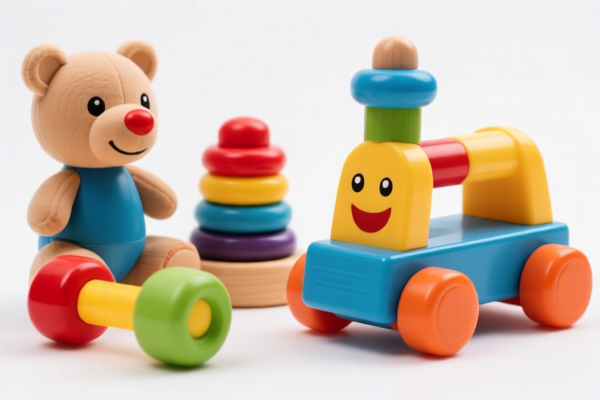| HS Code | Official Doc | Tariff Rate | Origin | Destination | Effective Date |
|---|---|---|---|---|---|
| 9503000011 | Doc | 30.0% | CN | US | 2025-05-12 |
| 9503000071 | Doc | 30.0% | CN | US | 2025-05-12 |
| 3924104000 | Doc | 33.4% | CN | US | 2025-05-12 |
| 3924905650 | Doc | 40.9% | CN | US | 2025-05-12 |




Playthings are objects used for amusement, recreation, or simply to occupy time. They encompass a broad range of items, often associated with childhood but enjoyed by individuals of all ages.
Material
Playthings are constructed from diverse materials, historically and presently including:
- Wood: A traditional material, offering durability and a natural aesthetic.
- Plastic: Mass-produced and versatile, allowing for complex shapes and vibrant colors.
- Metal: Used for construction toys, vehicles, and often incorporating moving parts.
- Fabric & Textiles: Employed in dolls, stuffed animals, and soft play items.
- Paper & Cardboard: Lightweight and inexpensive, suitable for crafts, games, and disposable toys.
- Rubber: Used for bouncing balls, figurines, and pliable toys.
- Electronics: Increasingly common, powering interactive toys, robots, and gaming devices.
Purpose
The primary purposes of playthings are:
- Entertainment: Providing enjoyment and amusement.
- Cognitive Development: Stimulating thought, problem-solving skills, and creativity.
- Physical Development: Enhancing motor skills, coordination, and spatial awareness.
- Social Development: Facilitating interaction, cooperation, and role-playing.
- Emotional Development: Providing comfort, companionship, and a means of expression.
Function
Playthings function through various mechanisms:
- Imitation: Representing real-world objects or scenarios (e.g., dolls, toy cars).
- Construction: Allowing users to build and create structures (e.g., building blocks, LEGOs).
- Manipulation: Requiring physical interaction and dexterity (e.g., puzzles, shape sorters).
- Imagination: Encouraging creative storytelling and role-playing.
- Competition: Fostering friendly rivalry and strategic thinking (e.g., board games, card games).
Usage Scenarios
Playthings are used in a wide variety of settings:
- Home: Indoor and outdoor play.
- Educational Institutions: Classrooms, preschools, and daycare centers.
- Public Spaces: Playgrounds, parks, and recreational facilities.
- Therapeutic Settings: Used in play therapy to address emotional and behavioral issues.
- Collections: Many individuals collect specific types of playthings as a hobby.
Common Types
Playthings are categorized into numerous types, including:
- Dolls & Action Figures: Representing people or characters, often used for role-playing.
- Building Blocks & Construction Toys: Encouraging creativity and problem-solving.
- Puzzles: Developing logical thinking and spatial reasoning.
- Board Games & Card Games: Fostering strategic thinking and social interaction.
- Vehicles: Representing cars, trucks, trains, and airplanes.
- Stuffed Animals & Plush Toys: Providing comfort and companionship.
- Balls & Outdoor Toys: Encouraging physical activity and coordination.
- Arts & Crafts Materials: Fostering creativity and self-expression.
- Electronic Toys: Interactive games, robots, and learning devices.
- Musical Instruments (Toy): Introducing music and rhythm.
The declared goods, “plaything,” encompass a range of items including tricycles, scooters, pedal cars, dolls’ carriages, dolls, and puzzles. These items are generally categorized as toys or recreational models. The following HS codes are relevant based on the provided information:
-
9503000011: This HS code covers tricycles, scooters, pedal cars and similar wheeled toys; dolls’ carriages; dolls, other toys; reduced-scale (“scaleˮ) models and similar recreational models, working or not; puzzles of all kinds; parts and accessories thereof, specifically those identified as “Children’s products” as defined in 15 U.S.C. § 2052 and labeled or determined by the importer as intended for use by persons under 3 years of age. The tariff details include a base tariff of 0.0%, a surcharge tariff of 0.0%, and an additional surcharge tariff of 30% effective April 2, 2025. The total tariff rate is 30.0%.
-
9503000071: This HS code also covers tricycles, scooters, pedal cars and similar wheeled toys; dolls’ carriages; dolls, other toys; reduced-scale (“scaleˮ) models and similar recreational models, working or not; puzzles of all kinds; parts and accessories thereof, but categorizes them as “Other” and identifies them as “Children’s products” as defined in 15 U.S.C. § 2052 and labeled or determined by the importer as intended for use by persons under 3 years of age. The tariff details include a base tariff of 0.0%, a surcharge tariff of 0.0%, and an additional surcharge tariff of 30% effective April 2, 2025. The total tariff rate is 30.0%.
Regarding HS codes 9503000011 and 9503000071, these products are defined as “Children’s products” as per 15 U.S.C. § 2052. It is important to accurately determine if the imported items are intended for use by persons under 3 years of age, as this classification impacts the applicable HS code.
Customer Reviews
No reviews yet.